学名: エピプレムナム・アウレウム
一般的な名前: ポトス、デビルズ・アイビー、デビルズ・ヴァイン
植物の種類 常緑つる性植物
属: エピプレムナム属
家族だ: サトイモ科
ポトス(Epipremnum aureum)は、つるを伸ばし、ハート形の葉で知られる人気の観葉植物です。一般に悪魔のツタとも呼ばれる。ポトスは南太平洋のソロモン諸島原産で、キク科に属する。原産地はソロモン諸島の熱帯雨林と考えられており、林床や樹上につる性植物として生育する。自然の生息地では、気根を使って樹木にしがみつき、栄養分を吸収する。さまざまな光量に適応し、多様な条件下で生育できることから、世界中で広く栽培され、観葉植物として人気を博している。
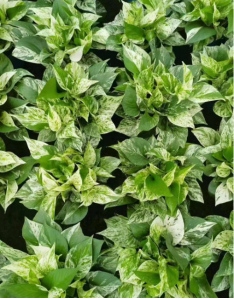
ポトスはつる性の植物で、かなり長く成長する。ハンギング・バスケットに植えられたり、支柱の上に登るように仕立てられたりすることが多い。つるは簡単に殖やすことができ、水や土で根付かせることができる。ハンギング・バスケットから垂れ下がらせたり、棚やテーブルの上に置いたりします。つるが垂れることで、美しいカスケード効果が生まれます。また、モスポールやその他の支柱を登るように仕立てれば、魅力的な垂直のディスプレイができます。
ポトスは手入れが比較的簡単な植物なので、ガーデニングの経験者にも初心者にも理想的です。時々手入れを怠っても大丈夫で、乾燥にも耐えることができます。しかし、最適な健康と成長を保証するために、適切な世話をすることが重要です。一部の文化では、ポトスは幸運、繁栄、ポジティブなエネルギーを家庭やオフィスにもたらすと信じられています。ポトスは、幸運、繁栄、ポジティブなエネルギーを家庭やオフィスにもたらすと信じられている。
ポトスの葉は、光沢のある革質で、ハート型か細長い形をしている。葉の大きさは品種や生育条件によって異なるが、一般的には幅2~4インチ(5~10cm)、長さ4~6インチ(10~15cm)である。最適な条件下では、1生育期で数フィート(約1.5メートル)成長することもある。成長が早いので、空いたスペースを素早く埋めたり、緑豊かなディスプレイを作るのに最適な品種です。葉の色は、緑、黄色、斑入りなどさまざま。最も一般的な品種は、緑の葉に黄色や白の斑が入るものだが、無地の緑やシルバー、あるいはブルーグリーンなど、葉の色が異なる品種もある。
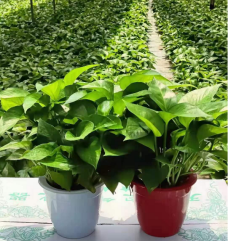
ポトスは、長く伸びた蔓が空間にみずみずしさと動きを与えます。カスケード状に伸びるため、ハンギングバスケットに最適で、つるが優雅に垂れ下がります。また、棚や本棚、部屋の間仕切りにも適しています。ポトスの葉は、つるに沿って交互に生え、それぞれの葉は節から出ています。ツルは葉を密に茂らせ、青々とした外観を作り出します。株が成長すると、つるの先端から新しい葉が出てきますが、古い葉は黄色くなり、徐々に落ちていきます。ポトスの葉は、茎に沿った小さな突起である葉節でつるにつきます。この節は、水や土に挿すと根を出す可能性があるため、繁殖には重要である。
ポトスは、その美しさ、成長の早さ、手入れのしやすさ、多用途性で珍重されています。ベテランの植物愛好家でも、インドアガーデンを始めたばかりの方でも、ポトスはあなたの空間に美的魅力と健康上のメリットの両方をもたらす、素晴らしい追加となるでしょう。
空気清浄: ポトス(Epipremnum aureum)は、空気を浄化する能力で知られている。空気中に存在する特定の有害物質を減少させることで、室内の空気の質を向上させることができる。他の植物と同様、ポトスも光合成の過程で酸素を放出します。これにより、周囲の空気中の酸素濃度を高め、より爽やかで健康的な室内環境を作り出すことができます。
ポトス植物は、ホルムアルデヒド、ベンゼン、トルエン、キシレンなど、空気中に浮遊する特定の揮発性有機化合物を除去する効果があることがわかっている。これらの化合物は、家具、カーペット、塗料、掃除用具など、一般的な家庭用品から排出される可能性がある。ポトスの植物は、これらのVOCを吸収・分解し、室内の空気の質を改善するのに役立つ。ポトスは、宇宙ステーションの室内空気の質を改善する方法を見つけることを目的としたクリーン・エア研究の一環として、NASAによって研究された植物のひとつである。この研究では、ポトスが空気中のホルムアルデヒド、ベンゼン、一酸化炭素、その他の化学物質を除去する効果があることがわかった。
ポトスの植物は、ほこりやその他の空気中の粒子を捕捉し、減らすのに役立ちます。ポトスの葉は天然のフィルターとして機能し、粒子を捕捉して空気全体の質を向上させる。葉は空気中の毒素を吸収し、根は毒素を分解して植物の栄養素に変えるのに役立ちます。
ポトスは室内の空気の質を改善するのに役立ちますが、それだけですべての大気汚染問題を解決できるわけではありません。健康的な室内環境を維持するためには、適切な換気、汚染源の削減、その他の適切な対策と併せて使用する必要がある。ポトスには空気浄化作用のほかにもいくつかの利点がある。室内空間に緑のタッチを加え、視覚的に魅力的な空間にしてくれる。また、ポトスを含む室内植物がストレスを軽減し、気分を高め、生産性を向上させることを示唆する研究もある。
軽い: ポトスは、弱い光から明るい間接光まで、幅広い光条件に耐えることができます。しかし、明るく間接的な光で成長する傾向がある。直射日光よりも、フィルターを通した明るい光を好みます。ポトスは、遮光カーテンのある窓際や、1日に数時間明るい間接光が当たる場所に置くのが理想的です。強い直射日光に長時間当てると、日焼けや葉の傷みの原因になるので避けましょう。
ポトスは低い光量にも耐えるので、自然光の少ない場所に適しています。ただし、光量が少ないと生育が遅くなったり、多彩な品種の場合、色づきが悪くなることがあるので注意しましょう。光量の少ない場所にポトスを置く場合、直射日光は葉を焦がしてしまうので避けましょう。
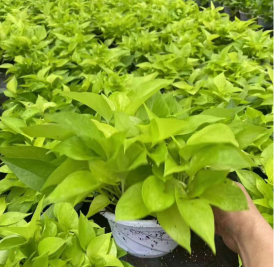
オトス植物はさまざまな光量に適応することができ、その反応に応じて光照射量を調整することができます。植物の葉が青白くなったり、脚が太くなったり、葉の色が変わってきたりした場合は、光量が弱すぎる可能性があります。一方、葉が黄色くなってきたり、茶色の斑点ができてきたりする場合は、光が強すぎる可能性があります。最適な光量が得られるように、ポトスの置き場所を適宜調整してください。黄色や白の多彩な模様があるポトスは、鮮やかな色彩を維持するために、一般的にやや明るめの光環境を必要とします。また、弱い光で長期間育てると、葉の緑色が薄くなったり、緑色の葉に戻ったりすることがあります。
光量が非常に少ない場所にポトスを植えている場合は、人工照明で必要な光量を補うことができます。植物の成長に必要な光のスペクトルを提供するために、LED成長ライトや蛍光灯を使用することができます。自然光を模倣するため、植物の数フィート上にライトを置き、1日10~12時間点灯させる。
ポトスはさまざまな光条件に耐えることができます。ポトスを観察し、直射日光が当たったり、薄暗くなりすぎたりすることなく、十分な光が当たるように適宜置き場所を調整してください。適切な光のバランスを見つけることは、ポトスの成長と全体的な健康にとって不可欠です。適切な照明に注意することで、ポトスは成長し、室内空間を美しく彩ることができます。
水だ: 適切な水やりは、ポトス(Epipremnum aureum)の健康と幸福のために不可欠です。ポトスはやや湿った土を好みますが、水やりの間の乾燥には耐えることができます。水やりの頻度は、鉢の大きさ、環境条件、土の保湿性などさまざまな要因によります。水をやりすぎたり、土が水浸しになったりすると、根腐れなどの原因になるので避けましょう。原則として、土の上部2.5cmが乾いてから水を与えます。土に指を刺して水分レベルを確認しましょう。通常、7~10日に1回の割合で水やりを行いますが、水やりの頻度には幅があります。水やりの頻度は、その植物が必要とする水分量に応じて調節してください。
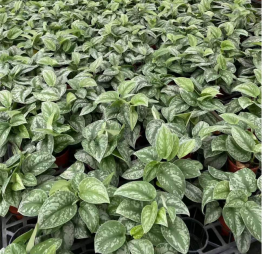
ポトスに水を与えるときは、土を十分に湿らせるようにします。鉢底から水が出るまで水をやり、根球全体に水分が行き渡るようにします。余分な水は排水し、根腐れの原因となるため、水が溜まったまま放置しないように注意しましょう。ポトスは弱酸性から中性の水を好みます。可能であれば、室温で濾過した水を使うか、水道水を一晩放置して、塩素やフッ素などの化学物質を飛散させる。軟水器で処理した水は、過剰な塩分が植物に害を与える可能性があるため、使用しないようにしましょう。
ポトスが水不足か過湿かを示すサインに注意してください。水不足の兆候には、しおれ、葉の垂れ下がり、土の乾燥などがあります。水のやりすぎは、ポトスにとってよくあるトラブルの原因です。過湿は根腐れやその他の問題を引き起こします。水やりの前には必ず土の水分レベルをチェックし、上部1センチが乾いていることを確認しましょう。土が常に湿っているように感じたり、葉の黄変や根腐れ、カビ臭いにおいがする場合は、水のやりすぎの可能性があります。これらのサインをもとに、水やりの頻度を調整しましょう。
ポトスは比較的寛容で、時折の乾燥には耐えることができますが、継続的な水のやりすぎは根腐れやその他の問題を引き起こします。土の水分レベルを観察し、それに応じて水やりを調整することで、ポトスの健康、活力、繁茂を保つことができます。
温度だ: ポトスは60°F (15°C) から85°F (29°C) の温度で生育する。ポトスは熱帯性植物であり、この温度帯はポトスの自然の生息地に見られる温暖で湿度の高い条件を模倣している。ポトスにとって理想的な温度は、21℃~24℃(70°F~75°F)です。この温度範囲であれば、過度な暑さはなく、暖かさのバランスがとれています。ポトスは、多少温度が低くても高くても耐えることができますが、好適温度範囲外の極端な温度に長時間さらされると、生育や全体的な健康に影響を与えることがあります。
ポトスは極端な温度変化に弱い。窓が開いていたり、エアコンの吹き出し口があったり、ラジエーターのような熱源が直接当たったりするような隙間風は避けてください。極端な低温や高温にさらされると、葉が傷んだり、成長が遅くなることがあります。ポトスは熱帯性の植物なので、冷たい隙間風や急激な温度低下には敏感です。10℃以下にならないように注意しましょう。冬の間は、隙間風が入るような場所や窓際には置かないようにしましょう。ポトスが好む温度より下がると、葉が変色したり、寒さで傷んだり、枯れたりすることがあります。ポトスは高温にも耐えることができますが、過度の高温は株 にストレスを与える可能性があります。気温が常に29℃を超える場合は、日陰を作るか、涼しい場所に移動させることをお勧めします。極端に暑い場合は、ポトスに直射日光が当たらないように注意しましょう。
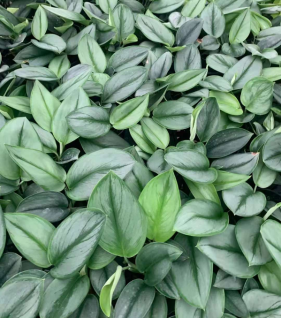
ポトスを好適な温度範囲に保ち、極端な環境から保護することで、ポトスの健康を確保し、最適な成長を促すことができます。ポトスにとって快適な環境を提供するために、植物が置かれている場所の温度をモニターし、必要に応じて調整することを忘れないでください。
土壌だ: ポトスは、余分な水が自由に流れ出るような、水はけのよい土壌を好みます。根腐れの原因になるので、長時間水を保持するような重い土や圧縮された土の使用は避けましょう。水はけのよい土は、湛水状態を防ぎ、根が呼吸できるようにします。保水性が高すぎる用土は、植物の健康に悪影響を及ぼすことがあります。水はけをよくするために、パーライト、バーミキュライト、ピートモスなどの成分が含まれている軽めの用土を探しましょう。堆肥やよく腐った肥料などの有機物を加えると、土の配合をさらに高めることができます。こうすることで、土壌構造が改善され、保水性が増し、栄養分も利用しやすくなります。ただし、有機物を入れすぎると土壌が過度 に圧縮されることがあるので注意する。
ポトスはpH6.0~7.0の弱酸性から中性の土を好みます。市販の培養土のほとんどはこの範囲内で配合されていますが、土壌検査キットで時々pHを測定し、必要に応じて硫黄や石灰を加えて調整するのがよい方法です。ポトスは、時々植え替えをすることで、新鮮な用土を与え、根の健全な成長を促すことができます。植え替えは通常、1~2年に1回、または現在の容器が手狭になったときに行います。植え替えの際は、現在使っている鉢より1~2回り大きな鉢を選び、新鮮で水はけのよい用土を詰めます。ポトスの植え替えの際は、土を詰めすぎないようにします。根の周りの土は、あまりきつく締め付けないように、やさしくなでるようにします。
水はけがよく、バランスのとれた用土を使用し、適切な容器を選ぶことで、ポトスに最適な土壌環境を作ることができます。定期的に土壌の水分レベルを観察し、それに応じて水やりを調整することで、植物の根系にとって健康的なバランスを維持することができます。
伝播: ポトスの増殖は比較的簡単で、茎の切断、水殖え、土殖え、空気殖えなど、いくつかの方法がある。

茎の挿し木: 親株から、少なくとも2つの節(葉が出るところ)がある健全な茎を選ぶ。 清潔で鋭利なはさみか剪定ばさみで、節のすぐ下にきれいに切り込みを入れる。 切り口の下部から葉を取り除き、上部に数枚の葉を残す。 切り口を水の入った容器に入れ、節が水に浸かるようにする。 容器は暖かく明るい場所に置いてください。 停滞を防ぐため、数日おきに水を交換する。
数週間後、根が伸び始めているのが見えるはずです。根の長さが数センチになったら、切り口を鉢に移し、水はけのよい土を入れる。
水の伝播: ポトスから健康なつるを選び、4~6インチの長さの茎を切る。 茎の下部から葉を取り除き、上部に数枚の葉を残す。水を張った容器か瓶に茎を入れ、節(葉がついているところ)が浸かるようにする。容器は、明るく間接照明の当たる場所に置く。水の停滞を防ぎ、清潔を保つため、数日おきに水を取り替える。 数週間後、根が形成され始めます。根が1~2センチほど伸びたら、切り口を鉢に移し、水はけのよい土を入れる。
土壌伝播: 水栽培と同様に、健康な茎を選び、4~6インチの長さに切る。下葉を取り除き、上部に数枚残す。茎の切り口を発根ホルモンに浸す(任意だが、発根を早める効果がある)。水はけのよい土を入れた小さな鉢に茎を挿す。鉢植え用ミックスか、パーライトとピートモスを混ぜたものを使う。土に軽く水をやり、鉢は明るく間接照明のあたる場所に置く。土は少し湿らせておくが、水浸しにはしない。時間が経つにつれ、挿し木は根を伸ばし、成長し始めます。
空気の層: 健康な茎を選び、節のすぐ下に上向きの小さな切り込みを入れる。切り口に発根ホルモンをまぶす。切り口を湿らせた水苔または湿らせたペーパータオルで包む。ラップでミズゴケを覆い、湿度の高い環境を作る。ラップを紐や結束バンドで固定する。時間の経過とともに、切り口から根が伸び始めます。根が十分に伸びたら、根のある部分の下を切り、別の鉢に植えることができる。
申し訳ありませんが、投稿が見つかりませんでした。別の検索をお試しください。